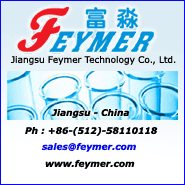
Jiangsu Feymer Technology Co., Ltd.
Click Here To EMAIL INQUIRYContact: Mr.Ricky Liu - Foreign Trade
Phone: +86-(512)-58110118 / 58110622 | Fax: +86-(512)-58110322
Address: Fenghuang Town, Zhangjiagang, Jiangsu 215613, China
E-Mail:
Web: http://www.feymer.com
Inquiry
Jiangsu Feymer Technology Co., Ltd. specializes in providing Functional Monomers and Water Soluble Polymers. Our products are widely used in water treatment, paper processing, textile processing, oil exploration & petroleum production, paint and coating industries. We also offer Pulp & Paper Chemicals, Water Treatment Chemicals, Oilfield Chemicals and Mining Chemicals.
Functional Monomer
Functional Monomer includes Amine Monomer, Cationic Monomer and Acrylamide Monomer. We offer different types of Cationic Monomers such as Diallyldimethylammonium Chloride, Methacryloyloxyethyl Trimethyl Ammonium Chloride, Acryloyloxyethyl Ttrimethyl Ammonium Chloride and Methacrylamidopropyltrimethylammonium Chloride. Diallyldimethylammonium Chloride is widely used in water treatment, textile chemical and in paper-making industries.
Bentonites
Mosaicatch® bentonites are used in paper making industry together with cationic polymers or starches, to increase the retention of fibers and fillers to enhance the efficiency of pulp draining. Our bentonites effectively absorb fiber, colloidal components and fillers. Bentonites are made by flouring of modified natural high whiteness bentonite.
Flocculant
Relyaquean® flocculant is an organic polymer which includes granular and fluid products. There are three types of products according to charge properties such as non-ionic, anionic and cationic charge, which cover the products with all range of charge density and series of different molecular weight & degree of cross-link. Our flocculant functions by neutralization of charge between long polymer chain and surface of suspensions in water. With neutralization of charge, absorption and bridging effect, flocculant can break colloid & form stable agrregation, therefore to separate the mud from water.
Water Solvent Macromolecular
Water Solvent Macromolecular Chemicals include Dimethyldiallylammonium Chloride Polymers, Poly[(dimethylimino)(2-hydroxy-1,3-propanedily)chloride], Polydichloroethyl Ether Tetramethyl Ethylene Diamine, Acrylic Acid Polymers, Acrylic acid-2-acrylamido-2-methyl Propyl Sulfonic Acid Copolymers, and DMDAAC/AM Copolymers. Dimethyldiallylammonium Chloride Polymer gathers electrolyte for the strong cation. It is a colorless to light yellow viscose liquid with a freezing point of -2.8°C, specific weight of 1.04 g/cm3, and resolve temperature of 280-300°C. Dimethyldiallylammonium Chloride Polymer is dissolved in water easily, and not easy to combust.Cationic Monomers
We offer different types of Cationic Monomers such as Diallyldimethylammonium Chloride, Methacryloyloxyethyl Trimethyl Ammonium Chloride, Acryloyloxyethyl Ttrimethyl Ammonium Chloride, and Methacrylamidopropyltrimethylammonium Chloride. Acryloyloxyethyl Ttrimethyl Ammonium Chloride is mainly used in water treatment, mineral recovery and paper making industries.Deposition Controllers
Optieloop® deposition controller is mainly used in circulating systems with water as medium, especially in paper making system. As deposition controller, Optieloop® can effectively control and remove the deposition or bio-film formed from inorganic chemicals and microorganism. Optieloop® can keep the system very clean, enhance the operating efficiency and pre-long the lifetime of equipments. It is easy to handle with pleasing fragrance. Deposition controller removes the deposition and biofilm and keep the system efficient.Retention Aids
Papformer® Retention Aids include granular and fluid products. There are three categories of products according to charge such as non-ionic, anionic and cationic, with predominance of cationic product. It also covers product with different cationic charge density and molecular weight, which can provide large variety of specific product according to the requirement of particular paper making machine or techniques. Papformer® retention aids, with solubility and adaptability towards various types of pulp, which can be used to increase the retention rate and speed of pulp draining on the wet end of paper & board machines. Papformer® retention aids can flocculate the fibers in pulp to form moderate aggregation by the mechanism of charge neutralization and bridging. The formed aggregation can embody tiny fiber and filler, therefore strongly be retained on paper. Moreover, the formation of aggregation forces out water inside and is beneficial to pulp draining. The increase of retention not only lowers the loss of fiber, filler and additives, also reduces deposits in paper making system and reliese the burden of white water and effluent treatment.